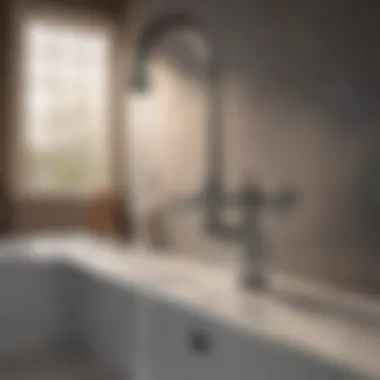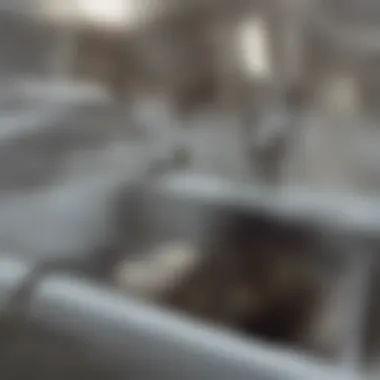Understanding Kitchen Sink Drain Water Issues


Intro
Water backing up through kitchen sink drains is a troubling issue for many homeowners. This phenomenon can lead to frustration and even costly repairs if not addressed promptly. Understanding the root causes and identifying practical solutions is essential for effective home maintenance. This article aims to provide a thorough exploration of the factors contributing to water backup, as well as actionable steps for troubleshooting and prevention.
Causes of Water Backup
Identifying the cause of water backup in a kitchen sink can be complex. Several key factors contribute to this problem:
Clogs in the Drain Line
- Food Particles: Small bits of food can accumulate and form a blockage. This can happen especially if the sink is not equipped with a proper strainer.
- Grease Buildup: Over time, grease can solidify in the pipes, leading to significant restrictions in water flow.
- Soap Scum: Residue from detergents can mix with grease and food particles to create stubborn clogs.
Plumbing Issues
- Pipe Damage: Cracked or corroded pipes can lead to leaks and backup. Regular maintenance can help identify issues before they escalate.
- Ventilation Problems: A poorly vented plumbing system can cause drainage issues. Proper venting ensures air can flow freely through the drain system.
Municipal Issues
- Sewer Line Problems: Backups can occur if there are blockages in city sewer lines. If multiple homes experience drainage problems, consider contacting local authorities.
Diagnosing the Problem
Once the possible causes are identified, the next step involves diagnosing the issue:
- Observe Water Flow: Notice when the backup occurs. Is it during heavy use or at specific times?
- Check for Other Issues: Look to see if other drains are also backing up. This can indicate a bigger plumbing problem.
- Visual Inspection: Remove the drain cover and inspect for any visible obstructions or buildup in the trap.
Solutions
Addressing water backup is essential for maintaining a functional kitchen. Here are some practical solutions:
Chemical Drain Cleaners
- Usage: These can dissolve clogs caused by grease and food particles. However, their use should be limited to not damage the pipes.
- Consider Alternatives: Homemade solutions using vinegar and baking soda may be effective for less severe clogs.
Physical Removal
- Plumber’s Snake: This tool can be useful for snaking out stubborn clogs.
- Hydro Jetting: For severe blockages, professional hydro jetting can clear stubborn buildups.
Regular Maintenance
- Routine Cleaning: Clean drains regularly using boiling water or a natural mix of baking soda and vinegar.
- Install Strainers: These can catch food particles and debris, preventing them from entering the drain.
Prevention Techniques
To avoid future occurrences of water backup, consistent maintenance is crucial:
- Educate Household Members: Encourage good practices, like avoid putting grease down the drain.
- Regular Inspections: Schedule regular plumbing inspections and maintenance to catch problems early.
"Maintenance is the key to preventing heavy plumbing issues in the future. Regular checks can save money and time."
By understanding the complex interactions in plumbing systems, homeowners can not only resolve but also prevent the inconveniences related to water backup in kitchen sinks. Taking proactive measures and keeping an eye on potential issues can lead to a more efficient and trouble-free home.
Culmination
Water backing up in the kitchen sink is a common but preventable issue. Understanding the underlying causes and taking appropriate actions can lead to improved plumbing health in the home. With regular checks, maintenance, and proper use of kitchen plumbing, homeowners can reduce the risk of future problems.
Prelude to Kitchen Sink Drain Issues
Understanding the functioning of kitchen sink drains is essential for homeowners. Water backing up can cause significant inconvenience, unpleasant odors, and potential damage to plumbing systems. Drainage issues can be symptomatic of larger problems in the plumbing infrastructure, making immediate recognition and resolution critical. This section aims to outline common drain problems and emphasize the importance of understanding how drainage systems operate.
Overview of Common Drain Problems


Several issues can affect kitchen sink drains. One prevalent problem is clogs caused by food particles, grease, and other debris accumulating within the pipes. These blockages hinder the free flow of water and can lead to overflow situations. Ventilation issues may also contribute to drainage problems. If the venting system is compromised, it can create pressure imbalances that prevent proper drainage.
Faulty garbage disposals can cause various problems, too. If the disposal unit is malfunctioning, it may not grind food waste properly, leading to stubborn clogs. In some rare cases, tree roots can infiltrate underground plumbing, causing more extensive damage. Awareness of these common drain issues prepares homeowners to take informed actions.
Importance of Understanding Drain Functionality
A deep understanding of how drain functionality works allows homeowners to troubleshoot issues effectively. Knowing the components of the drainage system, including pipes, traps, and vents, provides clarity about maintenance practices. It also aids in identifying signs of trouble early on, before they escalate into severe problems that require costly repairs.
"The key to effective drain maintenance is knowledge. Homeowners can prevent small issues from becoming major headaches with timely interventions."
Understanding the mechanics of water flow through the drain can illuminate potential problems, leading to timely action. This foundational knowledge fosters strategic preventative measures to maintain a functional plumbing system and reduce the likelihood of water backup in the kitchen.
Anatomy of a Kitchen Sink Drain
Understanding the anatomy of a kitchen sink drain is critical for addressing issues related to water backup. By grasping the individual components and their functions, homeowners can identify problems more effectively. This knowledge forms the foundation for troubleshooting and maintaining an efficient drainage system. The better you comprehend your kitchen sink's anatomy, the more prepared you will be to tackle any challenges that arise.
Components of the Drainage System
The drainage system of a kitchen sink comprises several key components:
- Sink Basin: The initial point where water collects before it flows down the drain.
- Drain Pipe: A length of piping that directs the water from the sink to the home's main drainage system.
- P-Trap: A curved section of pipe located below the sink that traps water, preventing sewer gases from entering the home.
- Vent Stack: A vertical pipe that allows air into the drainage system, promoting smooth flow and preventing siphoning.
- Tailpiece: This connects the sink drain to the P-Trap, capturing any debris or particles.
Understanding these components can help you diagnose issues such as clogs or improper ventilation. For example, a blocked P-Trap can lead to water backup and unpleasant odors due to trapped debris.
How Water Flows Through the System
The flow of water through the kitchen sink drainage system follows a specific path:
- Water enters the sink basin when you turn on the faucet.
- After use, gravity pulls the water down the drain pipe.
- The water then reaches the P-Trap, where some water remains to block odors.
- Once the water fills the P-Trap, it continues into the vent stack and eventually out to the main sewer line.
This process relies heavily on gravity and proper plumbing design. If any part of this system becomes obstructed, backup can occur. Knowing this flow is essential for any homeowner who wishes to understand their plumbing better.
Ensuring your kitchen sink drainage system is clear and functional prevents inconveniences related to water backup.
By dissecting the anatomy of a kitchen sink drain, you empower yourself to recognize problems early, thereby potentially saving time and money on repairs.
Causes of Water Backing Up
Understanding the causes of water backing up in kitchen sink drains is crucial. It helps homeowners identify issues early, potentially saving on costly repairs. These causes can range from simple clogs that can be addressed with basic tools to more complex problems requiring professional attention. By recognizing the type of problem that exists, homeowners can respond effectively and maintain the functionality of their plumbing systems. This awareness ultimately leads to reduced disruptions in daily life.
Clogs in the Draining System
Clogs are the most common reason for water backup. They can occur due to a variety of materials that accumulate in the pipes. Food particles, grease, hair, and soap residue often combine to form blockages. Over time, even small amounts can create significant issues. When a drain is clogged, water cannot flow freely, leading to back pressure and overflow.
How to Identify Clogging
Signs of a clog may include slow drainage or gurgling noises in the pipes. An obvious warning is water pooling in the sink after use. Homeowners should act promptly by using a plunger or a drain snake to clear minor clogs.
Ventilation Issues
Proper ventilation in plumbing systems is essential for maintaining a smooth flow of water. Vent pipes allow air to enter the system, which helps equalize pressure in the drains. Without this, blockages are more likely to occur, leading to water backing up.
Recognizing Ventilation Problems
A sign of ventilation problems is a slow drain that seems to worsen. Unpleasant odors may also emanate from the sink. If these issues persist, it may be necessary to inspect the venting system, which can be a more complex task requiring professional help.
Faulty Garbage Disposals
Garbage disposals play a significant role in managing waste in kitchens. However, when they malfunction, they can become a source of backup. Common issues include jams or electrical failures that prevent the disposal from functioning. When the disposal is not working correctly, waste can build up and cause water to back up into the sink.
Maintenance Tips for Garbage Disposals


To keep disposals in good condition, homeowners should avoid putting fibrous materials, grease, or non-food items down the unit. Regular maintenance, such as cleaning and inspection, can prevent many common issues.
Tree Root Infiltration
In some cases, the roots of nearby trees can infiltrate sewer lines, leading to severe backup issues. Roots naturally seek moisture, and if they find small cracks in the pipes, they will enter and grow. This not only blocks the flow of water but can also cause damage to the pipes themselves.
Symptoms of Tree Root Infiltration
Signs of root infiltration may include slow drainage and frequent clogs. If root issues are suspected, professional assistance is often necessary to address the damage and restore proper flow in the plumbing system.
Identifying Drainage Problems
Identifying drainage problems in a kitchen sink is crucial for maintaining a functional plumbing system. Understanding how to spot these issues can save time and prevent further damage. Homeowners who recognize the early signs of trouble usually face less expensive repairs and avoid potential emergencies.
Signs of a Clogged Drain
There are several indicators that a kitchen sink drain may be clogged. Recognizing these signs early can help to tackle the problem before it worsens. Here are some common symptoms:
- Slow drainage: Water does not flow freely down the drain, causing it to pool in the sink.
- Unpleasant odors: Foul smells can emanate from the sink, often caused by food debris trapped in the pipes.
- Gurgling sounds: Unusual sounds coming from the drain can indicate air trapped due to a blockage.
- Frequent backups: If water regularly rises back up the drain after use, this is often a clear sign of a clog.
- Overflowing sink: Water spilling over the sink indicates that there is a significant blockage that needs urgent attention.
Detecting these signs promptly can lead to more effective solutions and less inconvenience.
Using Diagnostic Tools
To accurately identify the root cause of drainage problems, various diagnostic tools can be utilized. Employing these tools can make the process of troubleshooting more efficient. Here are some recommended tools:
- Plumber's snake: A flexible tool that can dislodge clogs that are deep within the pipes.
- Drain camera: This device allows for a visual inspection of the interior of the pipes. It can reveal the condition of piping and the exact location of blockages.
- Auger: Used to break apart stubborn clogs that resist other methods.
- Water flow meter: Measures the flow rate of water through the pipes, helping to identify restrictions.
Using these tools effectively can help homeowners to accurately diagnose drainage problems and make informed decisions on how to address them.
Immediate Solutions for Backed Up Water
Addressing water backup in kitchen sinks is critical for maintaining the functionality of any home. When water starts to rise instead of flow down, it signals something isn’t working properly. This section provides immediate solutions to tackle the situation effectively, preventing further damage and inconvenience. Acting promptly can save you from more significant plumbing problems later, enhancing both comfort and hygiene in your kitchen.
Simple Home Remedies
There are various simple remedies you can try before calling in a professional. These solutions often utilize common household items and take minimal effort.
- Boiling Water: Pouring boiling water down the drain can help dissolve minor clogs caused by grease buildup. It's best to do this in stages to allow the water to work through the blockage.
- Baking Soda and Vinegar: A combination of one cup of baking soda followed by one cup of vinegar can work wonders. The reaction can dislodge food particles and debris. Wait for about 30 minutes before flushing with boiling water.
- Salt and Baking Soda: Similarly, mixing salt with baking soda (1/2 cup of each) can produce a drying effect on clogs. After pouring it down the drain, let it sit for several hours and then rinse with hot water.
These methods are not only effective but also eco-friendly. However, if the blockage persists, further intervention might be necessary.
Plumbing Tools You May Need
Having certain tools on hand can make clearing a backup much easier. While some issues can be fixed with household items, others may require more specialized tools. Here are essential tools for tackling backed-up drains:
- Plunger: A plunger acts as a first line of defense against clogs. Ensure it is the right type for kitchen sinks to maximize its effectiveness.
- Drain Snake: This tool helps reach deeper into pipes to dislodge tougher clogs. It's flexible enough to navigate bends in the pipes.
- Wet/Dry Vacuum: If you have access to a wet/dry vacuum, it can be a powerful ally in sucking out obstructions from the sink.
- Pipe Wrench: This is helpful if you need to disassemble parts of the plumbing to access the clog.
Preventative Measures to Avoid Future Issues
To ensure that water does not back up into the kitchen sink, it is essential to implement effective preventative measures. Prevention is often less costly and labor-intensive than dealing with a malfunction after it occurs. By recognizing potential problems before they escalate, homeowners can safeguard their plumbing systems. This section delves into three core preventative strategies that can significantly reduce the need for costly repairs and discomfort.
Routine Maintenance Practices
Regular maintenance is crucial to keeping your kitchen drainage system functioning smoothly. Here are some recommended practices:
- Frequent Cleaning: Regularly clean the sink and drains. Hot water mixed with vinegar can help break down minor buildups.
- Check for Leaks: Inspect pipes under the sink for leaks or damp spots. Early detection can prevent larger issues.
- Inspect the Garbage Disposal: Run the garbage disposal often and keep it clean to avoid clogs.
- Flush the System: Periodically flush the pipes using hot water to clear away grease and debris.
By incorporating these practices into your cleaning routine, you can minimize buildup and catch potential issues early.
Proper Disposal Methods


Disposing of kitchen waste correctly can have a significant impact on the health of your plumbing.
- Avoid Pouring Grease: Dispose of cooking grease in containers rather than pouring it down the drain, as it solidifies and creates clogs.
- Limit Food Waste: Be cautious of what you put down the disposal. Certain foods like fibrous vegetables or starchy substances can cause blockages.
- Utilize Composting: Whenever possible, compost food scraps to reduce what goes into the sink. This practice not only aids your plumbing but is also environmentally friendly.
Implementing these disposal methods can alleviate the strain on your drainage system.
Installing Drain Screens
Utilizing drain screens can effectively prevent debris from entering the plumbing system.
- Fine Mesh Screens: Install fine mesh screens over the sink drain to catch food particles before they enter the pipes. This is especially useful after cooking.
- Regular Checks: Clean the screens regularly to ensure they do not become clogged themselves.
Using drain screens is a simple yet effective way to maintain the integrity of the kitchen sink's drainage system.
By adopting these preventative measures, homeowners can mitigate potential drainage issues, ultimately saving time and financial resources.
When to Call a Professional Plumber
Understanding when to involve a professional plumber is crucial for effectively dealing with kitchen sink drainage problems. Homeowners may try to resolve issues independently, but some situations warrant expert intervention. Major plumbing problems can lead to more significant damage, increased costs, and inconvenience if not managed appropriately. Identifying these issues early prevents escalation and sustains the health of your plumbing system.
Indicators of Major Plumbing Issues
Several signs can indicate that you require the expertise of a plumber. Here are some of the most common indicators:
- Persistent Water Backups: If water keeps backing up despite attempts at clearing the drain, it could signal a deeper blockage or a problem in the sewer line.
- Multiple Drain Problems: When multiple drains are slow or clogged, it might indicate a significant issue with your plumbing system rather than isolated incidents.
- Foul Odors: Unpleasant smells from drains may suggest rotten food, waste buildup, or sewer line breaches.
- Gurgling Noises: Noises made when draining water can signal trapped air in the plumbing, often associated with blockages.
- Water Damage: Signs of water damage, such as stains on walls or ceilings, suggest leaks that may be hidden and require professional assessment.
It is essential not to ignore these signs, as they often indicate underlying issues that could complicate plumbing systems.
Benefits of Professional Services
Hiring a professional plumber offers numerous advantages, especially in critical situations. Here are some key benefits:
- Expert Diagnosis: Plumbers have the training and tools necessary to diagnose issues accurately. They can identify problems that a layperson might overlook.
- Safe Repairs: DIY attempts can sometimes exacerbate the issue or lead to unsafe situations. Professionals have the experience to handle the plumbing safely.
- Comprehensive Solutions: Professional services often come with warranties or guarantees. If problems recur after the repair, these services typically include follow-ups at no additional cost.
- Time Savings: Plumbers are more efficient. They can resolve problems faster than most homeowners, saving valuable time and reducing stress.
- Prevention of Future Problems: A skilled plumber can identify potential issues during repairs and suggest preventative measures to avoid similar problems in the future.
In summary, recognizing the signs of plumbing issues and understanding the benefits of professional intervention can make a significant difference in maintaining a functional kitchen sink drain.
Cost Implications of Drain Issues
Understanding the cost implications related to drain issues is vital for homeowners. Drain problems can lead to not only inconveniences but also significant expenses. The focus should be on how different issues affect overall budgets and financial planning. Addressing these problems promptly often saves money in the long run. Knowing the costs associated with both DIY solutions and professional services helps in making informed decisions.
Expected Costs of DIY Solutions
When facing drainage issues, many homeowners consider DIY solutions. This choice can be budget-friendly, but costs can vary significantly based on the complexity of the issue. Here are some common DIY costs:
- Basic Materials: Items like a plunger or drain snake generally cost between $10 to $30. These tools can effectively solve minor clogs depending on severity.
- Chemical Drain Cleaners: Prices range from $5 to $30. They can be effective for small blockages, yet caution is necessary due to potential damage they may cause.
- Plumbing Parts: Replacing parts like trap assemblies or rubber gaskets typically costs $15 to $50. Costs depend on material quality and specific parts required.
However, costs can escalate if the problem extends beyond minor fixes. Always assess your skills and the possible expenses involved before starting a DIY project.
Budgeting for Professional Repair Costs
In cases where DIY solutions do not suffice, consulting a professional plumber becomes necessary. Understanding the costs associated with professional services plays a crucial role in financial planning:
- Hourly Rates: Most plumbers charge between $45 to $200 per hour. Factors such as experience and region impact pricing.
- Service Fees: Many companies have a base service call fee, often ranging from $50 to $150, that covers transportation and diagnostics.
- Complex Repairs: For significant issues like pipe replacement or addressing sewer line problems, costs can exceed $1,000. It's essential for homeowners to prepare for the worst-case scenarios when budgeting.
Being proactive about drainage issues can mitigate unexpected financial burdens later on.
Thus, balancing between DIY attempts and professional services requires careful consideration of anticipated costs. By planning appropriately, homeowners can navigate these expenses and maintain their plumbing systems efficiently.
Ending
Understanding water coming up the kitchen sink drain is essential for any homeowner looking to maintain a functional and efficient plumbing system. The far-reaching implications of drainage issues can lead to major inconveniences and significant costs if not addressed promptly. An effective conclusion brings together the key elements discussed throughout the article, reinforcing their relevance and stressing the importance of proactive measures.
Summary of Key Points
- Identification of Causes: Knowing the causes of water backup is the first step. Understanding issues such as clogs, ventilation problems, and tree root infiltration can empower homeowners to address the root of the issue.
- Immediate Solutions: The article covers simple home remedies and necessary plumbing tools, allowing for quick management of minor drainage issues. This information is vital for those looking to take immediate action without defaulting to hiring a professional.
- Preventative Practices: Regular maintenance and proper disposal methods play a crucial role in preventing future problems. Small habits, like using drain screens and routine cleanings, can save homeowners from bigger issues later on.
- Understanding When to Seek Help: Knowing when it’s time to call a professional can help save time and ultimately money. Knowing the indicators of major plumbing issues is key for timely interventions.
Final Thoughts on Drain Maintenance
Maintenance of kitchen sink drains is not just about fixing problems as they arise; it encompasses a holistic approach to plumbing care. By incorporating routine maintenance practices and educating oneself about the functionality of their plumbing system, homeowners can greatly minimize their chances of future incidents. Moreover, investing time and resources into proper maintenance today can lead to long-term savings, less stress, and a more seamlessly functioning household. In this light, understanding and acting on the information provided in this article lays a solid foundation towards achieving a lasting plumbing solution.







